Booster for starting a diesel engine. We select a device for starting the engine with a dead battery. What to look out for
Autonomous starting device for a car can provide significant assistance when starting the engine, as well as charging the battery, especially when the generator power is not enough. A modern starting device is able to ensure the uninterrupted operation of passenger car engines, trucks, boats, boats, harvesters. Special models are used for jet, diesel as well as electric motors in aircraft, diesel power plants and trains. But still, starting devices for car batteries are most widely used.
Starter types
All currently produced starting devices can be divided into three types: household, professional And combined.
Home jump starters
Most affordable devices are household starting devices. The reason for this is the simplicity of design, ease of use, as well as low price such devices. The design of a household starting device includes:
- high power transformer;
- diode bridge;
- output voltage regulator;
- ammeter to control the magnitude of the current.
For all their simplicity and affordability, household starting devices for cars are not equipped with a user error protection system, and they also do not differ in the optimal battery charge mode, which, of course, does not add any pluses to them when assessed by their consumers. All all devices presented in the catalog have a starting battery that allows the device to work autonomously.
Professional starters
Professional launchers are an option that is best for car, since they have protection systems against the occurrence of short circuits and reverse polarity, are equipped with the ability to automatically control the charge current, and a system that stabilizes the supply voltage. The self-contained launcher is a semi-automatic yet easy-to-use portable equipment that the best way suitable for starting engines that include a carburetor. In addition, professional car starters are equipped with special clamps, with which the device can be connected to battery terminals, which ensures their durability in operation. They also differ in high power ratings.
Combined starting devices
The combined engine starter is a modified welding machine and therefore it is not very safe to use it to start a car. It is preferable to choose a model of a different type.
With intensive use of car starting devices, it is recommended to recharge them more often, since at low charge values, sulfates are released, leading to malfunctions of the device or even its complete failure. Therefore, it is necessary to carefully monitor the level of charge of the batteries, which must be maintained, at a level of 12.4 V. It is also important to note that the power source of the jump starter cannot be a normal "charge", since the required voltage value for the battery can be exceeded.
How to choose a launcher?
These cars are popularly called "boosters", "jump starters", "tarzans" and so on.
A small case that weighs, depending on the power, from 6 to 20 kg., will help the car battery to crank the starter. Also, the device can be used as an alternative source of energy when replacing a standard battery or during repair work, if it is necessary to disconnect the battery for power supply. on-board computer, alarms, etc.
Let's see how this device works and how it differs from a conventional car battery?
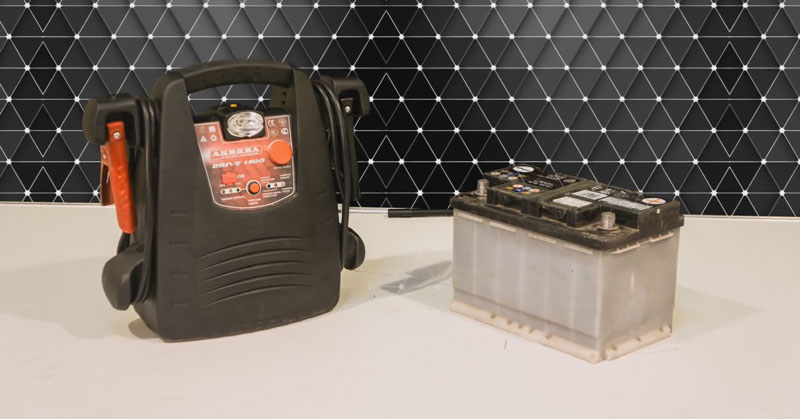
Booster - is a sealed battery, or several batteries packed in a convenient case. The device is equipped with an electronic charge control board, power cables with crocodile clips, a flashlight, a mains charger and a cable for charging the battery from the car's on-board network. Some models of devices have USB outputs powered by 5V.

In order to choose the booster you need, you need to pay attention to several important points- this is the voltage of the standard battery (12 or 24V), the required starting current and the capacity of the car battery.

According to the first criterion, devices can be divided into 2 categories:
12-volt DRIVE series devices that are suitable for starting cars, snowmobiles, generators and other similar equipment
24-volt devices of the DOUBLE DRIVE series (which, by the way, can also work with 12V batteries) are suitable for starting engines of powerful construction equipment, trucks, etc.
As for the starting current, there is a small but important nuance here: in those. The characteristics of the starting devices indicate 2 parameters of the starting current:
Peak value and Rated
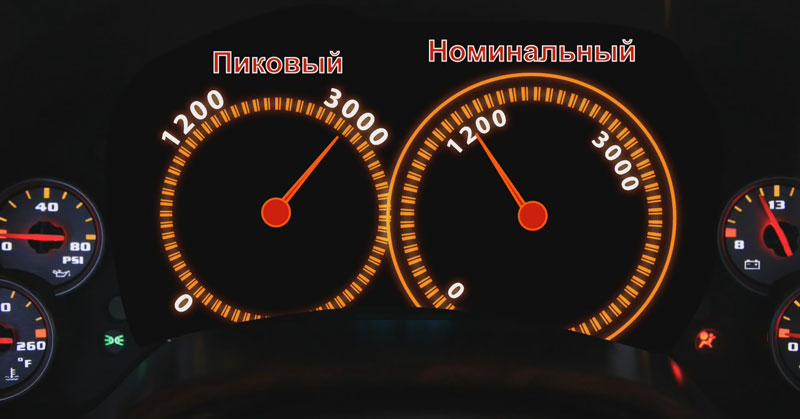
The peak starting current is much higher than the rated current and represents the value of the current that flows in the first fractions of a second of starting. This indicator shows how powerful the “starter” is able to give out an impulse in order to crank the starter.
The nominal value is an indicator of the strength of the starting current that the device is capable of delivering during a 3-second startup cycle.
As you understand, the higher the current parameters, the better.
The choice of a booster also depends on the capacity of the car's battery - the larger it is, the greater the capacity should be the battery of the starting device. So, to start a motorcycle, a launcher with a battery capacity of 17A / h will be more than enough, and a truck will need a battery with a larger capacity, for example, as on the Double Drive 3000 Turbo, which has 2 batteries installed, with a total capacity of 44A / h.
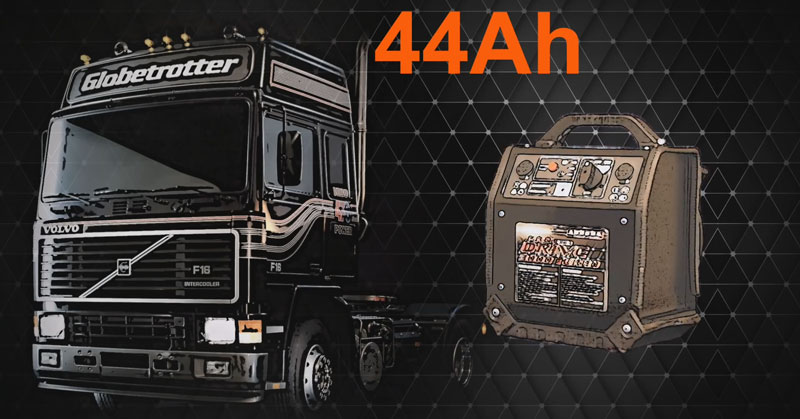
The buyer should know that the number of engine starts on one charge of the “jump starter” directly depends on the capacity of the device’s batteries and the degree of discharge of the regular car battery. The larger the battery capacity of the device, the more attempts to start the car owner can make.
For example, the battery capacity of the junior model in the AURORA DRIVE 900 line is 17 Ah,
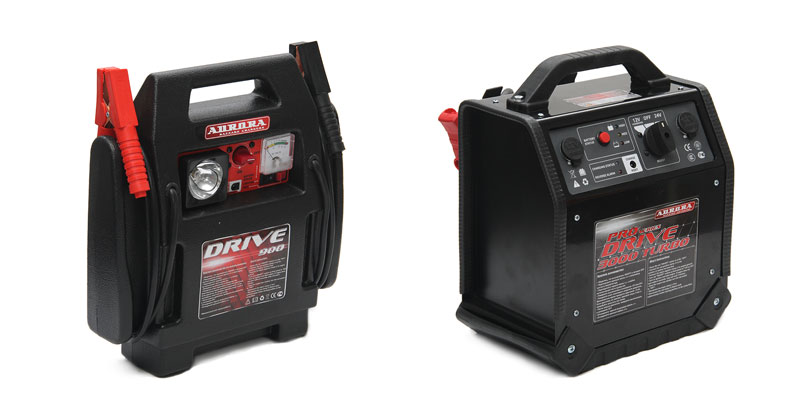
and the professional model AURORA DOUBLE DRIVE 3000 TURBO
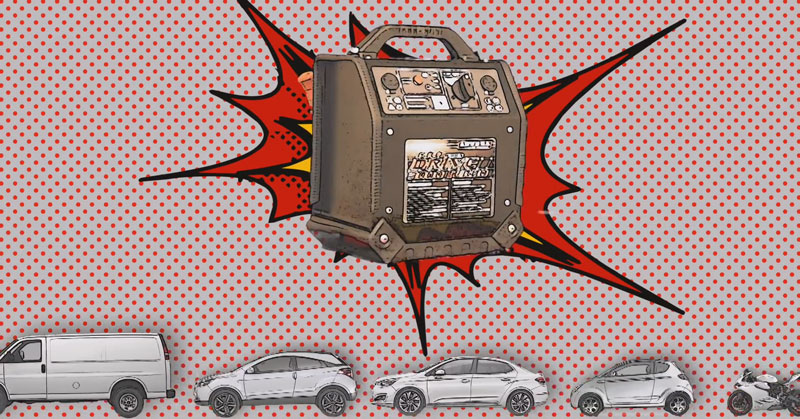
The capacity of two built-in batteries is 44 Ah.
A portable start-charger for a car is not a luxury, but a necessity; almost every thoughtful car owner should have such a unit. Severe dictate their own rules, they interfere with the normal functioning of the machine in cold weather. Often, under such conditions, batteries are discharged, and this happens at a very inopportune moment, when you urgently need to go on business. Starting systems will help to start a cold engine and not “land” the battery.
This invention will help to start the engine without outside help
The device and principle of operation of a powerful unit
To begin with, we will deal with the principle of operation of the starting device. Today, four types of such units are widely used all over the world. Let's get acquainted with the performance of starting-charging elements of a pulsed, transformer, battery (in other words, a booster) and capacitor type.
Pulse
From the very name it becomes clear that the principle of operation is "tied" to the voltage that has passed the pulse conversion. High frequencies act on the voltage in such a way that it increases, then decreases, and as a result undergoes a transformation. Such a device has little power, which is why it can only be used as a recharge for a standard battery. In cold winters, its properties are greatly weakened, it is prone to power surges, it can create significant interference in the network, which is important, it is too difficult to repair. Its main advantage is its low weight and low cost.
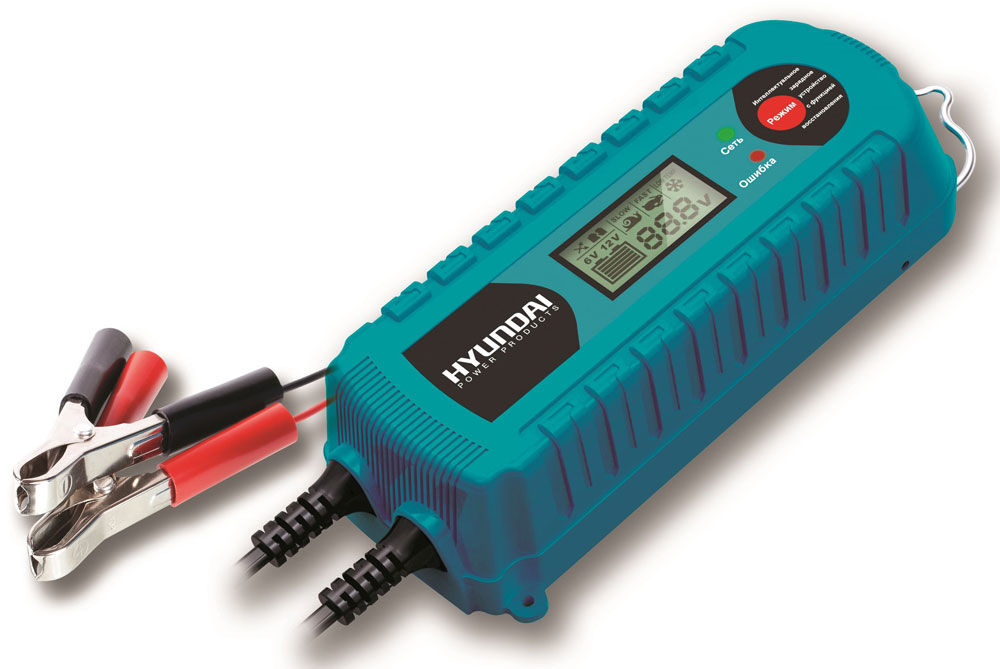
transformer
This charger operates on the basis of a voltage step down transformer. Such units are characterized by high power and excellent starting currents. Even in the case of a completely discharged battery, transformer “charges” will help start power unit car. Of the significant drawbacks, it is worth noting the very large weight and size, as well as the rather high cost.

Rechargeable
To start the power unit, standard batteries are used, which are initially recharged. Among them there are household and professional devices. The first ones have a built-in charger and which will not help the car owner start the car regularly at low temperatures. As for professional units, they are equipped with wheels for easy movement and several batteries with a capacity of up to 190 Ah.
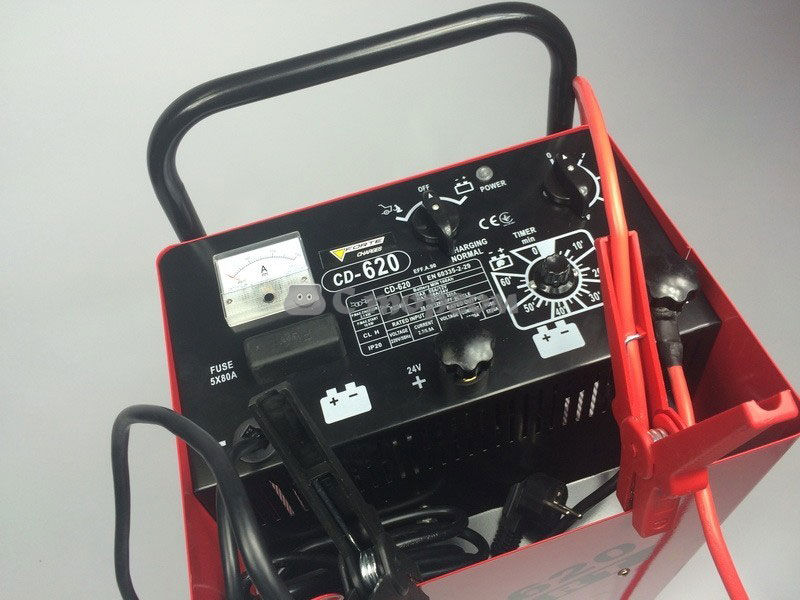
Capacitor
It is not easy to work with this type of units, initially you need to put built-in capacitors on charge, only after that start the power unit. In everyday life, they are extremely rare, this is due to the high cost of capacitors, the inability to charge several cars in a row and the negative impact on the car battery.
Types and features of starting-charging elements
The charger can be three types- it depends on its capabilities. Car owners can purchase household, professional or combined units.
A household charger is usually used in garage conditions, it works with a 12 V car on-board network, charges batteries and starts engines of various vehicles.
Professional starting systems are more versatile, they are able to function with machines where the mains voltage is 12 V and 24 V.
The appearance on the market of combined starting-charging units has made life easier for many motorists. The engine start element is multifunctional, however, quite difficult to use.
Portable chargers
A portable start-charger will help the car owner start the power unit in case of unforeseen problems with the battery, in addition, it will recharge the dead battery of a cell phone, laptop or tablet.
Let's make our rating of the most popular models. Let's consider this equipment, focusing on its characteristics, manufacturer's brand, as well as price / quality ratio. Car owners tend to purchase the products of leading companies, as she managed to "show" herself on the successful side. Consider the 10 most practical models:
- Berkut Smart Power SP-8N;
- Carku E;
- D-Lex Powerbank;
- "SOROKIN" 12.94;
- Orion PW700;
- "Orion" PW150;
- Intertool AT-3013;
- Bosch C3.
Berkut Smart
The main characteristics of Berkut starter battery equipment:
- huge capacity (4500 mAh);
- two specialized outputs (5 V and 12 V);
- initial current 202.5 A.
One of its main advantages is its compact dimensions. The best equipment is protected by a plastic base with control buttons. Sidebar , which displays the charge level and elements for determining the operating mode. This unit has an LED flashlight and a connector for connecting a built-in battery. In addition to the equipment itself, the complete set includes power wires, as well as "crocodiles" that can be connected to a machine battery. Unlike other models below, the device has short circuit protection. This circumstance causes a considerable cost of the product - about 7000 rubles.

carku
Carku portable charger for car belongs to one of the Chinese manufacturers, has the following characteristics:
- capacity 1200 mAh;
- several outputs (5 V, 12 V and 19 V) - this will help increase the amount of charging both in a car battery and in a laptop or mobile gadget;
- starting current 200 A.
The plastic base of the unit is attractive with an unusual stylish shape. All necessary control panels are located on the back of the case. There are also inputs and outputs for charging various gadgets. It is worth noting a huge amount of additional headset that comes with the product: various wires, alligator adapters, several types of plugs. This launcher-charger is not very expensive - about 3700 rubles. This unit has one feature that exalts it above other models - perfect functioning, not even dependent on frequent starts.
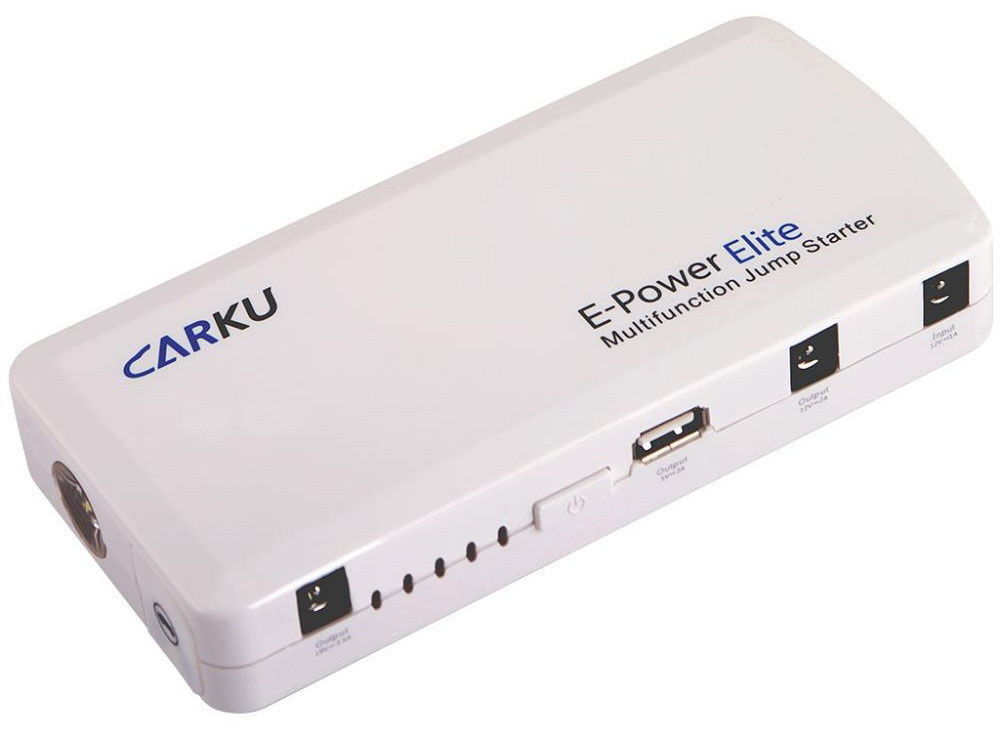
D-Lex Power Bank
The D-Lex Powerbank has identical features to its predecessor (Carku). They differ only in the absence of a portable launcher charger for car D-Lex Powerbank dedicated outlet for laptop charging. The red-black plastic base attracts with its successful design. The top panel is equipped with a power button, the front and rear sides have an LED flashlight, charge level indicators, a power input and several outputs, including USB. The kit, placed in a special case, includes power wires, as well as an adapter cable. The purchase of such a charger will cost 4500 rubles.
SOROKIN 12.94
Many car enthusiasts gave their preference to the domestic manufacturer, the starter-charger for the SOROKIN 12.94 car is in no way inferior to its foreign counterparts with its characteristics:
- capacity 3–80 Ah;
- Multiple 12V and 6V outputs.
The automated unit is equipped with an unusual recharging mode, which has 9 stages. This device is safe for car electronics, it can be connected to the battery. The device contains a program for fast and. The charger has an excellent package, in particular: alligator contacts, a cigarette lighter socket and ring terminals. The cost of the device fluctuates around 3,800–4,000 rubles.
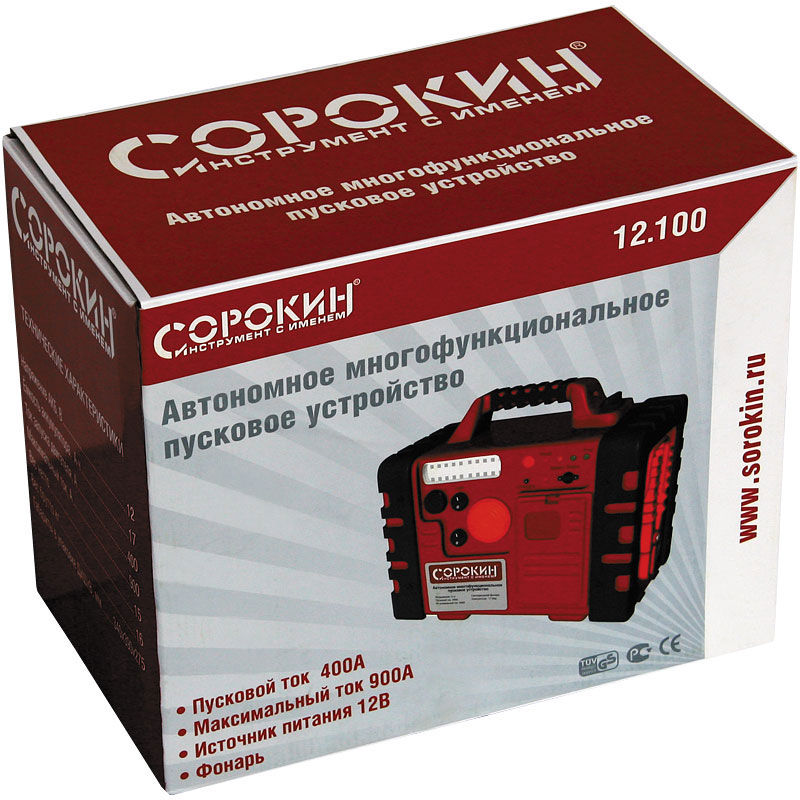
Orion PW700 and Orion PW150
The attention of car owners deserves such a device as the Orion PW700, which is slightly better than the Orion PW150. This car starter charger provides a quality charge resulting from work of three circuits with voltage feedback. Basic properties:
- charging current 16 A;
- battery voltage 6V and 12V.
This multifunctional device is great for charging any car battery in any condition. A feature of this device is forced ventilation with a complete fan. Orion PW700 is equipped with an emergency system for monitoring the level of internal temperature. The unit is able to start from scratch the power devices of both cars and trucks in the winter at very low temperatures and after long-term storage of the car. The cost is about 4700 rubles.
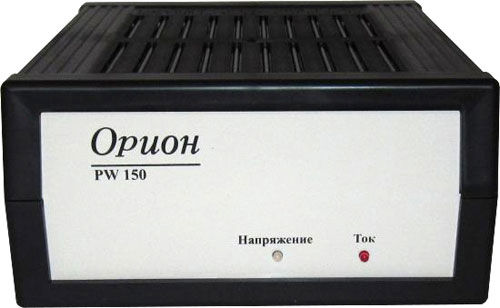
"Orion" PW150 will be beneficial for motorists who are looking for a device with the best combination of price and quality. The unit is easy to use, it does not provide any "bells and whistles". Even a novice driver can easily deal with it. Device Specifications:
- voltage 12 V;
- charging current 5.5 A.
The cost of this kit is 1950 rubles.
Intertool AT-3013
The Intertool AT-3013 car charger is equipped with a protective system to avoid overcharging, a clear indicator, a voltage regulator, and an ammeter. Even a completely discharged battery can be charged with this device. The main advantages of this charger are: low weight, small size and the ability to charge the car battery even while driving. Basic properties:
- multiple outputs (12V and 6V);
- starting current 70 A.

The cost of such a kit is 1900 rubles.
Bosch C3
Bosch C3, manufactured by China, is considered the most understandable imported device. Crocodile contacts are included in the package, however, they are not, you will have to do it yourself. To control the level of internal temperature and protect against overcharging, a fuse is built into the device. An additional nice accessory is a hanging loop.
- capacity 1.2–120 Ah;
- battery voltage 6 V, 12 V;
- charging current 0.8–3.8 A.
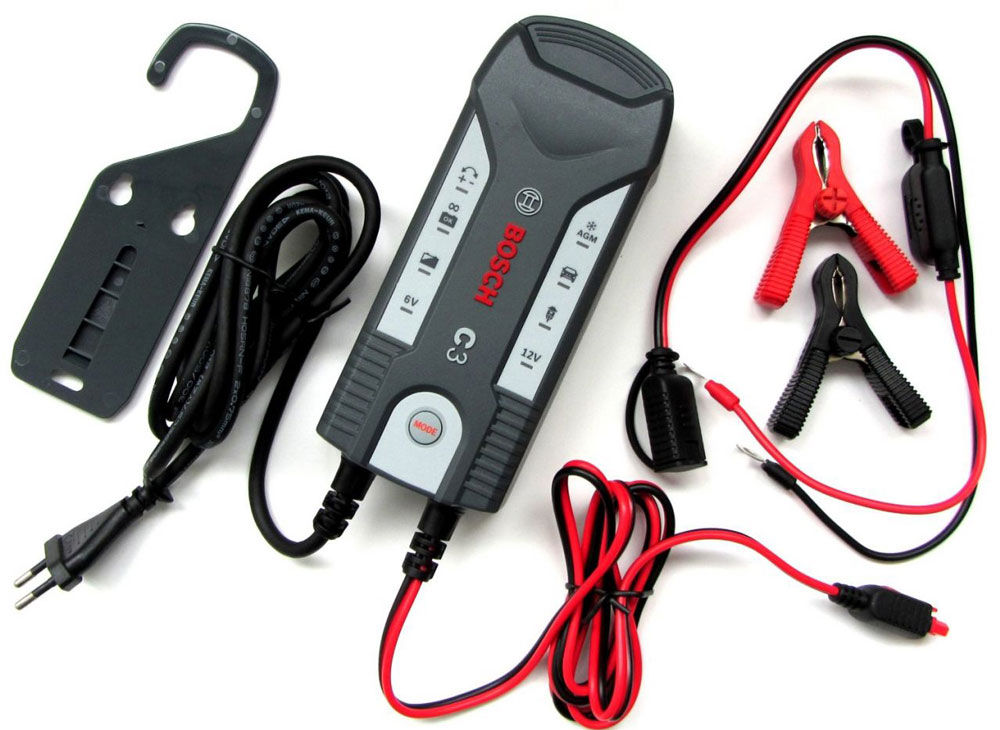
The cost of the kit is 4500 rubles.
Conclusion
The above multifunctional devices proved to be excellent on the road, helped car owners to cope with malfunctions. However, before acquiring this or that model for yourself, it is best to learn as much as possible about it. If it is not possible to do it yourself, look on the Internet for a video for the device you are interested in.
The best prices and conditions for the purchase of new cars
Credit 4.5% / Installment / Trade-in / 95% approval / Gifts in the salonMas Motors
Previously, when the engine failed to start at the most crucial moment, the car owner had to resort to all known manipulations: look for a “donor” for “lighting up”, charge or warm up the battery if there was no help, or even completely change the battery to a new one. In cases with primitive technique, as a rule, it was possible to get by with the “pusher” technique altogether. Now, anyone, if they take care of it in advance, can cope with such a situation alone and quickly by starting a seemingly completely dead engine with a tiny booster, the capacity of which can be comparable to three smartphones. Starting this review, we decided to collect the most diverse samples in terms of their characteristics - excellent sizes, cost and power, in order to determine which accessory is intended for what purpose. By no means a compact "launcher" on foreground you don’t see it by chance - we specially involved him in this review. Can compact jump starters compete with proven "battery cases"? And if so, which one to choose? Motorists are probably also concerned about more pressing issues: how reliable is such a device, for example, and whether it is convenient to use intended purpose- as a power bank to various electronic devices? Today we will find out. First you need to understand the design, because there are things here that can confuse an inexperienced car owner.
CHARGE SOURCE
The very concept of a “starter-charger”, which is now widely used, is not entirely correct: this characteristic is more suitable for devices powered by a household network that can actually charge the battery and work in the starting booster mode. The lion's share of the compact devices on the market belong to the category of starting devices and are equipped with lithium-polymer (Li-Po, Li-pol) rechargeable batteries- similar ones are used in smartphones, tablets and other compact gadgets. It's on this moment the most modern and advanced of the massively used types of batteries. Such a battery is an advanced design of a lithium-ion battery, the main difference of which is the use of a gel-like electrolyte, which makes it very thin and gives it almost any shape. By design, the batteries are as close as possible to the batteries used in radio-controlled models and even in some modern electric vehicles, and are rectangular plates. The nominal voltage of each of them is 3.7 V, in a fully charged form - 4.2 V, and in a fully discharged form - 3 V. Further discharge, like overcharging, disables the element. That is why the battery, consisting of three series-connected elements, occupies only two-thirds of the device case: the rest of the space is reserved for electronics (controllers, DC / DC converters, capacitors, transistors, etc.).
ELUSIVE CAPACITY
Surely when choosing such a booster, as in the case of buying a smartphone, pay attention to the value called "capacity". The characteristic, of course, is important, but you need to rely on it with slight amendments: the parameter measured in ampere-hours primarily shows the magnitude of the electric charge and only partially characterizes the real capacity of the batteries. For example, the "ampere-hours" indicated on a standard car battery cannot always be compared with a similar characteristic of a jump starter. It's all about how this value is measured. For most devices, including those presented in our review, the capacity is not entirely correct, since the value in ampere-hours directly depends on the voltage at which the measurement is made: for example, at a nominal voltage of 3.7 V, the capacity of the battery booster Carku can be 15,000 mAh, when charging a smartphone through a 5-volt USB port, the capacity will be less.
To calculate the actual capacity at 5V, divide the absolute capacity (15,000mAh x 3.7V = 55,000mWh) by the USB output voltage: 55,500mWh / 5V = 11,000mAh. It is this parameter that you should focus on when charging gadgets: 11,000 mAh at a voltage of 5 V, taking into account various losses that can be 15–20%, should, for example, be enough for 4–5 full charges of a smartphone with a battery capacity of 2000 mAh.
But when the motor starts, the energy will be removed already through the starting wires, and the capacity at 12 V will be 4583 mAh. Most honestly, this value is indicated for the Whistler device, which produces 33,000 mWh - a characteristic that shows not stored charge, but stored energy. If necessary, this value can be translated into the most common capacity designation that competitors usually claim directly for the initial voltage of battery cells, divided by 3.7 V (33,000 mWh / 3.7 V = 8920 mAh) or for the most useful voltage indicator ( 12 V), which is important directly when starting the motor (33,000 mWh / 12 V = 2750 mAh). Berkut's approach can be considered no less honest: in the Smart Power booster, the capacity is indicated just for a voltage of 12 volts and is close to 2600 mAh, and when recalculated for 3.7 V, the capacity will be equal to 8432 mAh (2600 x 12 V / 3.7 V ). But why, with similar parameters, are the dimensions of the devices so different? According to the company's technical specialist, the main task in designing the device was to achieve maximum security (only Smart Power has 10 degrees of protection!), And a lot of "air" inside the case provides the batteries with better ventilation. The characteristics of the rest of the "launchers" are indicated in more familiar parameters, and the tradition itself has developed historically and is explained very simply: it is corny easier to "sell" a larger capacity. But who really stands out against this background is the heavy launcher Aurora. It has two sealed lead-acid batteries, the total capacity of which is an honest 34 Ah at 12 V, and the peak current at start-up can reach an impressive 1500 A!
READY FOR LAUNCH!
We decided to test the devices simple method without in-depth studies regarding charge currents, voltages, etc. For the test, a VAZ “classic” was chosen with a serviceable, but pre-planted battery. And in order to eliminate the effect of fast recharging during a successful engine start, it was decided to turn off the fuel supply. It is worth noting that the engine capacity is relatively small (1.5 liters), and the air temperature was kept at around 0 ° C, which, of course, made it easier for our devices to work. As a result, absolutely all gadgets successfully coped with their work, turning the crankshaft of the Zhiguli motor over and over again: each device, even the tiny Neoline, made 5 successful “launches” total length for 3–4 seconds (device manufacturers do not recommend “turning” more) and was ready for further work. After that, for greater clarity, one run of a 3.7-liter V6 was performed on a Jeep Liberty car with a planted battery. The charge remaining in the devices is roughly comparable to the declared capacity of the boosters, although the LED indicators do not make it possible to accurately assess the remaining energy. If you believe the readings of the scales, Carku, Harper, Whistler and Smart Power were discharged by 30–40%, Airline and Neoline - by 40–50%, and Aurora proved to be a completely unkillable “starter”: the starter turned the most vigorously, and the loads seemed to and didn't feel it. In this mini-test, we did not have the task of direct comparison, we mainly tried to show the variety and diversity of gadgets on sale.
Preventive charging of a healthy battery a couple of times a year minimizes the risk of its sudden discharge even in very coldy. It is more convenient to use fully automatic memory (pictured Daewoo DW 1500)
PREVENTION
As an annoying doctor, I never get tired of repeating: it is not the symptoms that need to be treated, but the cause of the disease! Even after successfully “lighting up” and turning off the engine after half an hour, the next time you start, you can fail again. The main thing is to follow simple rules operation of the battery: monitor the good contact and condition of its terminals, the serviceability of the electrical equipment of the car as a whole, the electrolyte level and its density (in serviced batteries), do not leave current consumers switched on for a long time, and if a battery malfunction is suspected, check its performance or contact to the service. After all, even daily trips (especially short-term ones) are not able to restore the battery every time to the end. Therefore, even a serviceable battery in a fully serviceable car needs preventive charging from the household network 1-2 times a year, which will minimize the likelihood of its unexpected discharge even in the most severe frost. It is most convenient to deal with automatic chargers. This time, to recharge the planted batteries, we took for a test the so-called intelligent charger of the young brand Daewoo Power Products, main feature which is to self-assess the condition of the battery and set the charging current and voltage accordingly. To put the device into operation, a minimum of actions is required: after connecting the terminals of the device to the battery contacts, the function of automatically determining the type and condition of the battery will start. If the battery is good (otherwise the corresponding inscription will light up), then after 10–15 minutes of diagnostics, you will need to select the charging mode (slow, standard or fast), after which the automatic charging process will begin. If the battery is heavily discharged, low current charging begins with a gradual increase in voltage until a normal charge level is reached. There is also a battery recovery mode (desulfation), which also works automatically: it turns on the voltage supply in a pulsed mode, which allows you to remove sulfates from the surface of the lead plates, thereby restoring the battery capacity. In general, the device turned out to be successful, especially considering its versatility (it can work with most types of 6/12/24 V batteries with a capacity of 20 to 300 Ah), safety and ease of use (protection against incorrect connection, short circuit and overheating is provided).
VERDICT
The longer a brand exists on the market, the better the quality of its products, as a rule. Moreover, the level of brand development in this area cannot be neglected: the production of starter boosters requires high-quality production and constant monitoring, which often cannot be afforded by “no-name” manufacturers. Also, the provision of a factory warranty cannot be discounted: in most cases, the manufacturer is ready to meet the needs of the client and change failed devices. No less attention should be paid when buying a jump starter technical specifications the ROM you are interested in and the possibilities of its application on certain vehicles. It is worth asking about the presence of built-in protection circuits - the more of them, the better. Of course, this will affect the cost of the device, but a good electronic device, moreover, intended for automotive use in extreme conditions will never be cheap. So, we have formed three main categories of devices provided on the market.
1. If the main task is a powerful charger for a smartphone, and the ability to start a car is an extreme case, then you can stop at budget compact models whose capacity does not exceed 8000–10,000 Ah. Airline is perfect for these purposes (on its side there are two USB ports with different characteristics, an informative display, a good flashlight and good launch options), as well as Neoline, which won over with a truly compact size. Whistler can also be attributed here: yes, it is more expensive, but its rubberized body is more practical, and the overall impression of the product is higher than that of competitors.
AIRLINE APB-08-03
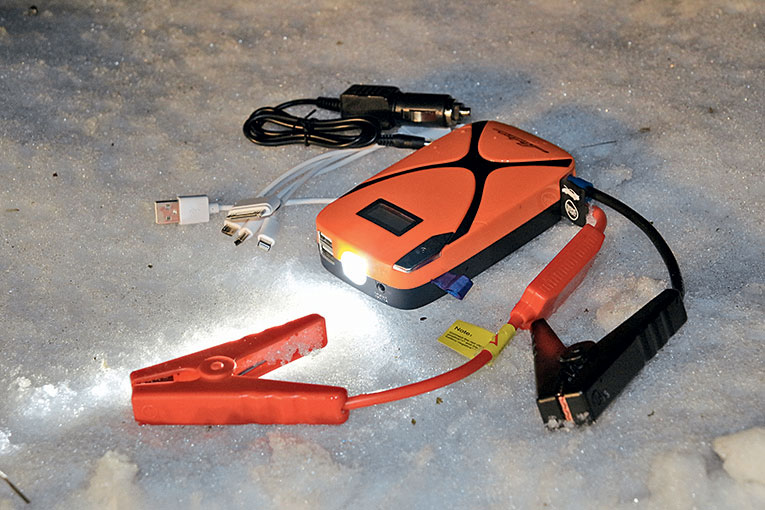
- Interesting design, compact size, LCD display, 2 USB slots
- No case included
NEOLINE JUMP STARTER 80

- The smallest body and weight among competitors with similar parameters, low price
- Uninformative charge indicator, no storage case, dim flashlight
WHISTLER JUMP AND GO

- Solid case, rubberized case, storage case, long cigarette lighter wires with soldered crocodile clips
- Uninformative charge indicator
2. If, in addition to the above requirements (charging gadgets via USB and infrequent car starts), you plan to periodically charge your laptop, then you should look at models that have an appropriate 15/19 V output. The larger the capacity, the better. In our test, only Harper turned out to have this option, although almost every manufacturer has such boosters in their assortment. I liked the device as a whole - mainly the ratio of characteristics and price.
HARPER ES 12085
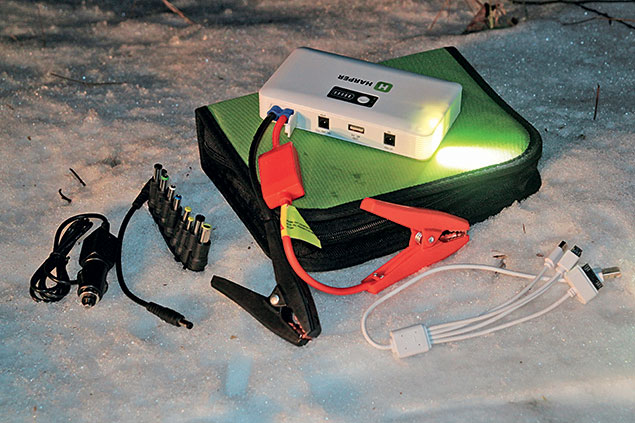
- Good equipment, the ability to charge laptops, low price
- Impractical plastic case, uninformative LED charge indicator
3. If you find yourself dealing with constant car revivals a lot (maybe you're a car mechanic, or maybe just virtue itself), then there are a few options here. Heavy equipment is still more relevant for a car service: either the Aurora Double Drive 1500 “suitcase”, or the more compact, but less productive Carku E-Power-43 and Smart Power SP-2600. Each model has its own characteristics. Aurora really stands out from the rest of the "kids" and has a colossal capacity that allows you to start even truck diesel engines. You have to pay for this with a lot of weight, price and a rather long charge from the network. The Karku brand, as one of the pioneers in our market, has already gained an excellent reputation in itself - in my opinion, it is quite deserved. The tested Power-43 model is one of the few that, in addition to excellent performance, can boast of a dust and moisture resistant case. Smart Power SP-2600 has its own chips: the device has the highest degree of protection among competitors, which directly affects the safety of work, and the resource, and the reliability of the device.
AURORA DOUBLE DRIVE 1500

- High-quality performance, high capacitance and starting current, cigarette lighter socket, 12/24 V output, powerful power cables
- Large dimensions and weight, long charging and the need for it every 3 months
CARKU E-POWER-43
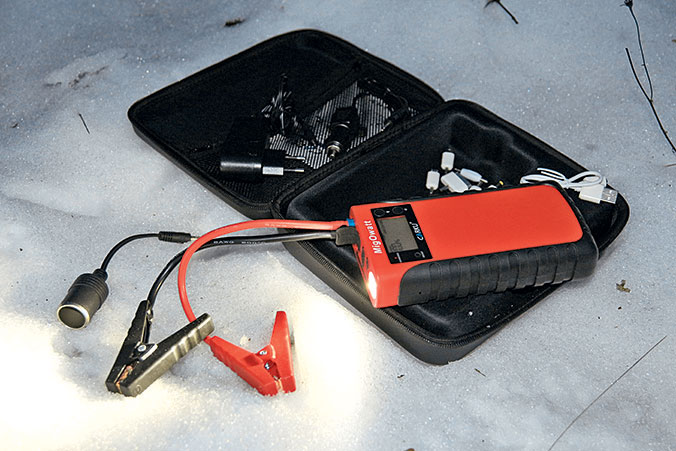
- Hard case, rich package, 12V cigarette lighter socket, large capacity, dust and moisture-proof housing, LCD display, intelligent protection unit
- Lack of 19V socket for laptop charging
SMARTPOWER SP-2600
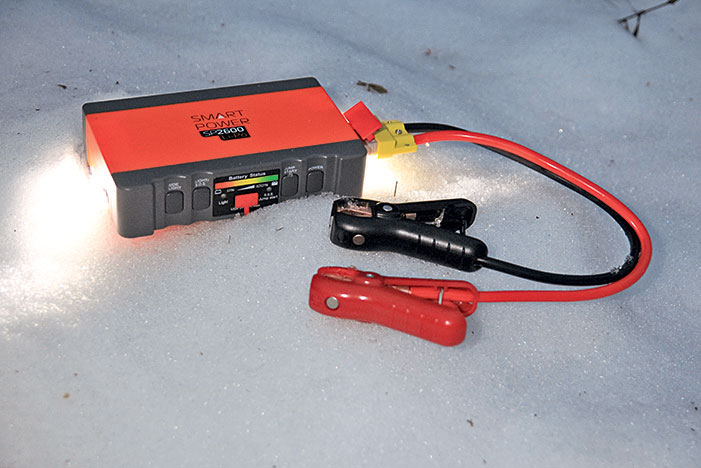
- Powerful wires for lighting, solid housing, high safety of use with 10 degrees of protection
- Price, not the most convenient "crocodiles", uninformative charge indicator, modest capacity
| Specifications | |||||||
| CARKU | HARPER | WHISTLER | SMART-POWER | AIRLINE | NEOLINE | AURORA | |
| Dimensions, mm | 265x190x60 | 145x80x30 | 130x78x24 | 192x122x47 | - | 131x75x25 | |
| Weight, g | 590 | 420 | 450 | 660 | 500 | 225 | 11 500 |
| USB output (5 V), A | 2 | 2 | 2,1 | 2 | 2,1 + 1 | 2 | - |
| Ability to charge a laptop | - | 12/16/19 V | - | - | - | - | - |
| cigarette lighter socket | 12 V, 10 A | - | - | - | - | - | 12 V |
| Capacity, (mAh) at 3.7 V | 15 000 | 12 000 | 8920 | 8432; 2600 (at 12V) | 8000 | 8000 | 37 000 |
| Stored energy, Wh (approximately) | 55 | 44,4 | 33 (passport data) | 31,2 | 29,6 | 29,6 | 444 |
| Starting current, A (min./max.) | 250/500 | 200/400 | 200/400 | 117/234 | 200/400 | 200/400 | 700/1500 |
| Charging time, h | 4–5 | 3 | 3–4 | - | - | - | - |
| Charge indicator | LCD display | LED scale | LED scale | LED scale | LCD display | LED scale | turnout |
| Flashlight | There is | There is | There is | 2 pcs. | There is | There is | There is |
| Charging cycles | >1000 | 1200 | >1000 | 2000 | 3000 | 1000 | - |
| Price, r. | 7990 | 4200 | 7190 | 9200 | 4900 | 3500 | 10 100 |
In the winter cold in the morning, it is very tempting to buy a device to start the engine with a dead battery. Probably, there is no driver in nature who would not ask at least once to light a cigarette from neighbors in the parking lot or did not look for sympathizers to push his car (naturally, in the latter case, the car must be equipped with mechanical box).
Even attentive and caring car owners are not guaranteed against a sudden battery landing: in the cold, it holds a charge poorly, even if it has not yet had time to grow old. Constantly relying on someone's help is not very reasonable: everyone can have time to leave the parking lot, or no one will find crocodiles, or there will be no time to wait until your battery comes to life.
Spend money for optional equipment, of course, it's a pity, but a one-time investment can save a lot of nerves and time.
Device for starting the engine with a dead battery may have different manufacturers: such units are produced by both Asian companies and firms of the CIS countries.
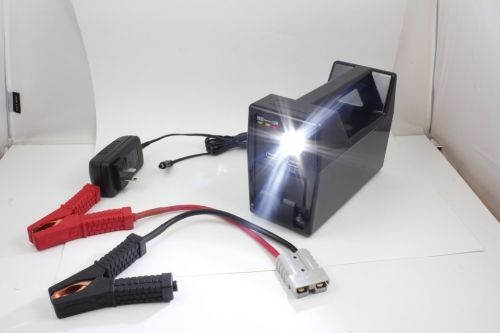
Start charger as such
The device is better known among the people under the name "booster". Unenlightened people believe that this is a kind of spare battery. The deepest delusion: charging has at least 3 cardinal differences:
- the capacity of the booster is much less than that of the on-board battery (maximum 30Ah);
- completely different internal content - lead-electrolyte;
- produces an inrush current of 1000 A or more.
- The starting device is connected directly to the engine. Such a booster is only suitable for cars where the engine is not more powerful than 125 horses;
- The unit is thrown by the same “crocodiles” directly onto a dead battery and gives a current sufficient to start and initially recharge (then the generator comes into play).
Boosters are charged from a household electrical outlet. In the cold, you should not leave them in the car: the fate of the on-board battery may befall. However, almost all of them are quite compact. The only exceptions are professional and semi-professional, with which they come to the rescue from a car service: they can weigh up to 5-7 kg.
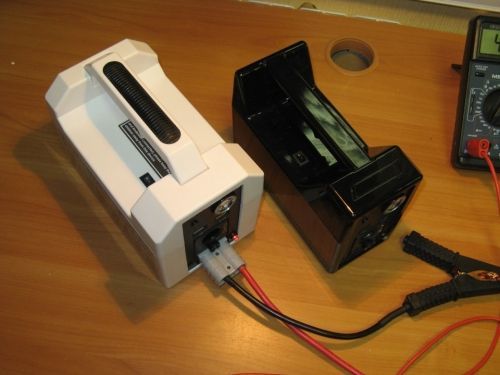
Booster functionality
If you have already decided to acquire such a device, choose one that will be convenient to use - and not only to start the engine.
- When choosing a model, choose one with a battery indicator. Without such a scoreboard, using a booster will be, to put it mildly, inconvenient;
- Spend a little more money, but buy a device with built-in zero discharge protection: this model will last much longer;
- It is advisable to choose a booster that provides the ability to charge other devices. For example, the Russian s-start at the output provides voltage 5V/2A, 12V/2A, 19V/3.5A, thanks to which it can be used to recharge tablets, smartphones and even a laptop. USB ports and adapters are available;
- When buying a booster, pay attention to its power: for example, Taiwanese-made devices are clearly distinguished by purpose - for cars and jeeps;
- There are flashlights in almost all launchers. But whether you need additional functions - decide for yourself.
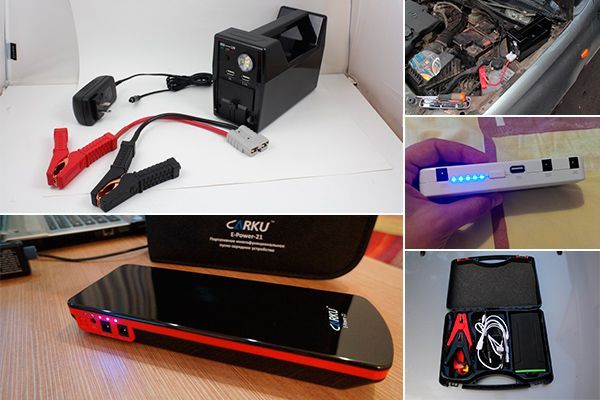
Don't get divorced!
Hundreds, and maybe thousands of motorists have already become victims of advertising. A dubious device called the Start Genie is selling like hot cakes. Gentlemen, learn the materiel and think logically! If the majority of high-quality boosters start at $150, and the simplest ones start from 5 thousand rubles, then the cost of 1.5-1.9 thousand should at least alert.
The use of this charger should cause no less embarrassment: Start Genie sticks into ... the cigarette lighter!
To start the engine, even for a low-power car, you need a message of 200 A, and the cigarette lighter can withstand only 15. It is simply not able to transmit the current of the required strength. Firstly, it will burn itself out, and secondly, it’s scary to even imagine what will happen to the computer if it is on the car. Enthusiasts who bought the Start Genie, tried to charge it and failed to do so, broke open the booster case and found 20 AA batteries in it. Almost 2 thousand for this kit seems a bit expensive.
Remember: a real device for starting the engine with a dead battery is thrown onto it or the motor, and not into a hole designed for completely different purposes.




